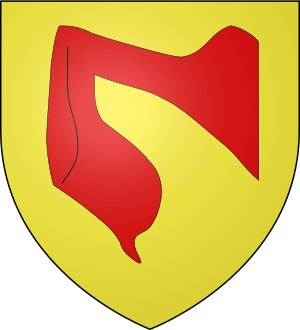John Hastings, 1st Baron Hastings facts for kids
John Hastings (born May 6, 1262 – died February 1313) was an important English landowner, soldier, and leader. He was known as the 1st Baron Hastings. He was one of the people who wanted to become King of Scotland in 1290. He also signed a special letter in 1301 called the Barons' Letter. This letter was a protest against the Pope.
Contents
Early Life and Family
John Hastings was born in 1262 in Allesley, near Coventry in England. He was the oldest son of Henry de Hastings. His father was called Lord Hastings in 1263. However, this title was not officially recognized by the King at that time.
John's mother was Joanna de Cantilupe. She was a very wealthy heiress. Her family owned a lot of land. When her brother, Sir George de Cantilupe (who had no children) died in 1273, John Hastings inherited many of these lands.
Becoming a Powerful Lord
In 1273, John Hastings became the 13th Lord of Abergavenny. This meant he gained control of Abergavenny Castle and a huge amount of land. He also inherited other family estates, like Aston Cantlow. This was one of his family's main homes.
Serving the King
From the 1290s, John Hastings fought in wars for King Edward I. He fought in Scotland, Ireland, and France. He also held important jobs for the King. He was the Seneschal of Gascony and Lieutenant of Aquitaine at the same time. These were big leadership roles in French territories controlled by England.
In 1290, John Hastings tried to become King of Scotland. He was a grandson of Ada, who was a granddaughter of King David I of Scotland. But he was not successful in his claim.
Also in 1290, he was officially called to the English Parliament. This made him a peer, with the title Lord Hastings. In 1301, he signed and sealed the Barons' Letter of 1301. This letter was sent to Pope Boniface VIII. It was a protest from English lords about the Pope trying to get involved in Scottish matters.
Family Life
John Hastings was married two times.
His first wife was Isabel de Valence. She was the daughter of William de Valence, 1st Earl of Pembroke. They had several children:
- William Hastings (1282–1311): He was their oldest son. He died before his father.
- John Hastings, 2nd Baron Hastings (1286-1325): He was the oldest son who lived longer than his father. He became the next Baron Hastings. He married Juliane de Leybourne. They had a son named Lawrence Hastings, 1st Earl of Pembroke.
- Joan Hastings (died 1307): She married William de Huntingfield. She was buried in the Hastings Chapel in Greyfriars, Coventry.
- Elizabeth Hastings: She married Roger Grey, 1st Baron Grey de Ruthyn.
His second wife was Isabel le Despenser. She was the daughter of Hugh le Despenser, 1st Earl of Winchester. They had more children:
- Thomas de Hastings
- Margaret de Hastings
- Sir Hugh Hastings (died 1347): He lived in Sutton and had children.
Death and Burial
John Hastings died in February 1313. He was 50 years old. His oldest living son, John Hastings, 2nd Baron Hastings, took over his title.
John Hastings and his first wife, Isabel de Valence, were buried together. They were laid to rest in the Hastings Chapel at the Greyfriars Monastery in Coventry. His parents were also buried there. The chapel had stained glass windows that showed the coats of arms of his family and their important connections.

| Peerage of England | ||
|---|---|---|
| New creation | Baron Hastings 1290–1313 |
Succeeded by John Hastings |


